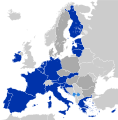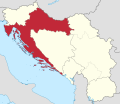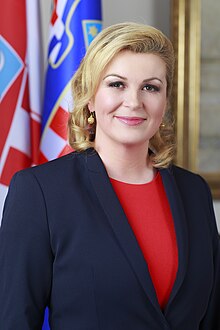Welcome to the Croatia Portal !hrvatski portal !
Flag of Croatia Coat of Arms of Croatia
Croatia kroh-AY -shə Croatian : Hrvatska , pronounced [xř̩ʋaːtskaː] Republic of Croatia (Croatian: Republika Hrvatska ), is a country in Southeastern Europe . Its coast lies entirely on the Adriatic Sea . Croatia borders Slovenia to the northwest, Hungary to the northeast, Serbia to the east, Bosnia and Herzegovina and Montenegro to the southeast, and shares a maritime border with Italy to the west. Its capital and largest city, Zagreb , forms one of the country's primary subdivisions , with twenty counties . Other major urban centers include Split , Rijeka and Osijek . The country spans 56,594 square kilometres (21,851 square miles), and has a population of nearly 3.9 million.
The Croats arrived in modern-day Croatia in the late 6th century, then part of Roman Illyria . By the 7th century, they had organized the territory into two duchies . Croatia was first internationally recognized as independent on 7 June 879 during the reign of Duke Branimir . Tomislav became the first king by 925, elevating Croatia to the status of a kingdom . During the succession crisis after the Trpimirović dynasty ended, Croatia entered a personal union with Hungary in 1102. In 1527, faced with Ottoman conquest , the Croatian Parliament elected Ferdinand I of Austria to the Croatian throne. In October 1918, the State of Slovenes, Croats, and Serbs , independent from Austria-Hungary, was proclaimed in Zagreb, and in December 1918, it merged into the Kingdom of Yugoslavia . Following the Axis invasion of Yugoslavia in April 1941, most of Croatia was incorporated into a Nazi-installed puppet state, the Independent State of Croatia . A resistance movement led to the creation of the Socialist Republic of Croatia , which after the war became a founding member and constituent of the Socialist Federal Republic of Yugoslavia . On 25 June 1991, Croatia declared independence , and the War of Independence was successfully fought over the next four years.
Croatia is a republic and a parliamentary liberal democracy . It is a member of the European Union , the Eurozone , the Schengen Area , NATO , the United Nations , the Council of Europe , the OSCE , the World Trade Organization , a founding member of the Union for the Mediterranean , and is currently in the process of joining the OECD . An active participant in United Nations peacekeeping , Croatia contributed troops to the International Security Assistance Force and was elected to fill a non-permanent seat on the United Nations Security Council in the 2008–2009 term for the first time.
Croatia is a developed country with an advanced high-income economy and ranks highly in the Human Development Index . Service , industrial sectors , and agriculture dominate the economy . Tourism is a significant source of revenue for the country, with nearly 20 million tourist arrivals as of 2019. Since the 2000s, the Croatian government has heavily invested in infrastructure, especially transport routes and facilities along the Pan-European corridors . Croatia has also positioned itself as a regional energy leader in the early 2020s and is contributing to the diversification of Europe's energy supply via its floating liquefied natural gas import terminal off Krk island, LNG Hrvatska . Croatia provides social security , universal health care , and tuition-free primary and secondary education while supporting culture through public institutions and corporate investments in media and publishing . (Full article...
Entries here consist of Good and Featured articles, which meet a core set of high editorial standards. A panorama of port and the city in the background.
The
Port of Rijeka (
Croatian :
Luka Rijeka ,
IPA: [lǔːka rijěːka] ) is a
seaport in
Rijeka ,
Croatia , located on the shore of the
Kvarner Gulf in the
Adriatic Sea . The first records of the port date to 1281. It was the main port of the
Kingdom of Hungary in the 19th century and the beginning of the 20th century, of
Yugoslavia between
World War II and 1991, and of
Croatia after its independence. Today, it is the largest port in Croatia with a cargo throughput of 13.6 million tonnes (2020), mostly oil, general cargo and
bulk cargo , and 344,091
Twenty-foot equivalent units (TEUs). (
Full article... )
List of recognized articles
Did you know (auto-generated)
The following are images from various Croatia-related articles on Wikipedia.
Image 1 Croatian borders similar to those established with the
Peace of Karlowitz in 1699. Although the peace treaty meant relief from Ottoman pressure, Croatia lost the compactness of its territory. (from
History of Croatia )
Image 2 Two parts of the Triune Kingdom: Croatia-Slavonia (number 17) and Dalmatia (number 5) within Austria-Hungary (from
History of Croatia )
Image 3 Cathedral of
St Stephen in
Zagreb , the capital of Croatia, the 14th century interior (from
Culture of Croatia )
Image 4 Self-portrait with Dog (
Autoportret sa psom ) by
Miroslav Kraljević (1910)
Modern Gallery, Zagreb (from
Culture of Croatia )
Image 5 Plitvice Lakes,
IUCN Category II (
National Park ) (from
Culture of Croatia )
Image 6 A 16th century depiction of
Vrana monastery , seat of
John of Palisna . (from
History of Croatia )
Image 7 Baška Tablet (from
Culture of Croatia )
Image 8 The 1835 issue of the magazine
Danicza , with lyrics of what would later become the Croatian national anthem "
Lijepa naša domovino " ("Our Beautiful Homeland"). (from
History of Croatia )
Image 9 The assassination of Croatian MPs in the National Assembly in Belgrade was one of the events which greatly damaged relations between Serbs and Croats in the Kingdom of Serbs, Croats and Slovenes. (from
History of Croatia )
Image 10 Clockwise from top left: The central street of
Dubrovnik , the
Stradun , in ruins during the
Siege of Dubrovnik ; the damaged
Vukovar water tower , a symbol of the early conflict, flying the
Croatian tricolor ; soldiers of the
Croatian Army getting ready to destroy a
Serbian tank; the
Vukovar Memorial Cemetery; a Serbian
T-55 tank destroyed on the road to
Drniš (from
History of Croatia )
Image 11 Portal of the
Trogir cathedral by sculptor
Radovan , c. 1240 (from
Culture of Croatia )
Image 12 Josip Broz Tito led
Yugoslavia from 1944 to 1980; Pictured: Tito with the US president
Richard Nixon in the
White House , 1971 (from
Croatia )
Image 13 A border marking of Illyrian Provinces on Sava river shores in modern-day
Zagreb . (from
History of Croatia )
Image 15 A chair designed by Bernardo Bernardi in 1956. (from
Culture of Croatia )
Image 16 Kingdom of Croatia c. 925, during the reign of
King Tomislav (from
Croatia )
Image 18 President
Zoran Milanović on
NATO summit on 11 July 2023,
Vilnius , Lithuania. The accession of Croatia to
NATO took place in 2009. (from
Croatia )
Image 19 Portrait of a Roman woman, found in
Solin (Salona),
Croatia . (from
Culture of Croatia )
Image 20 Savka Dabčević-Kučar ,
Croatian Spring participant; Europe's first female prime minister (from
History of Croatia )
Image 21 Cardinal
Aloysius Stepinac with the Croatian communist leader
Vladimir Bakarić at the celebration of
May Day , shortly before Stepinac was arrested and convicted by the communists, he became a symbol of resistance to the communist regime in
Yugoslavia . (from
Croatia )
Image 22 Croatians in a caffe bar on Petar Preradović Square, also known as "Flowers Square" (
Cvjetni trg ), in
Zagreb (from
Culture of Croatia )
Image 23 Cremeschnitte of
Samobor (from
Culture of Croatia )
Image 24 Fans on
Poljud stadium during Croatia's biggest football derby between
Hajduk Split and
Dinamo Zagreb . (from
Culture of Croatia )
Image 25 Ban
Josip Jelačić at the opening of the first Croatian civic Parliament (
Sabor ) whose deputies were elected on 5 June 1848. In earlier Sabors, members represented feudal estates rather than citizens. The Croatian tricolor flag can also be seen in the background. Dragutin Weingärtner, 1885. (from
History of Croatia )
Image 28 University of Zadar , 1396, Croatia's oldest university (from
Culture of Croatia )
Image 29 Zlatni Rat beach on the Island of
Brač is one of the foremost spots of
tourism in Croatia . (from
Croatia )
Image 32 A man wearing
Lika cap . (from
Culture of Croatia )
Image 33 Fascist leaders of
Nazi Germany and its puppet state
Independent State of Croatia ,
Adolf Hitler and
Ante Pavelić , meeting in
Berghof outside
Berchtesgaden , Germany, 1941 (from
Croatia )
Image 35 Radio Zagreb , now a part of
Croatian Radiotelevision , was the first public radio station in Southeast Europe. (from
Croatia )
Image 36 A tower on top of
Croatian Radiotelevision (HRT) building in
Zagreb neighbourhood of Prisavlje. (from
Culture of Croatia )
Image 38 Croatian musical
diva Josipa Lisac . (from
Culture of Croatia )
Image 40 Traditional Croatian musicians playing
violins (from
Culture of Croatia )
Image 41 Poglavnik of the Independent State of Croatia,
Ante Pavelić , shakes hands with
Adolf Hitler in 1941. (from
History of Croatia )
Image 42 The
flag of Croatia was hoisted together with the
flag of Europe on the building of the Ministry of Foreign and European Affairs in Zagreb as a symbol of Croatia's membership in both the
Council of Europe and the
European Union (from
History of Croatia )
Image 43 Dubrovnik is one of Croatia's most popular tourist destinations. (from
Croatia )
Image 44 People of Zagreb celebrating
liberation on 12 May 1945 by
Croatian Partisans (from
Croatia )
Image 45 Iapodic headwear and other material culture from
Gacka valley , Croatia. (from
History of Croatia )
Image 46 Vučedol dove - the most famous piece of bronze age
Vučedol culture . (from
Culture of Croatia )
Image 48 A map of the Istrian peninsula from the Roman map
Tabula Peutingeriana , made sometime in the 4th century (from
History of Croatia )
Image 49 Skywalk in
Biokovo Nature Park (from
Croatia )
Image 51 A map of 10th-century Croatian counties (
županije ), as they were mentioned in
De Administrando Imperio . The counties marked in blue, represent the territories governed by the Croatian Ban. (from
History of Croatia )
Image 52 Proclamation of severing ties with
Austria-Hungary in front of
Croatian Sabor in 1918. (from
History of Croatia )
Image 53 Historic centre of
Trogir has been included in the
UNESCO list of
World Heritage Site since 1997. (from
Croatia )
Image 54 Tounj bridge on
Jozephina road (from
History of Croatia )
Image 55 The
Baška tablet is the oldest
Glagolitic monument in Croatia. It documents the donation of land gifted by
Croatian King Dmitar Zvonimir to the
Benedictine monastery of St Lucy. (from
Croatia )
Image 56 Croatia became the 28th EU member country on 1 July 2013. (from
Croatia )
Image 57 Pula Film Festival is held each year during summer. Its main stage is
Roman amphitheatre in Pula. (from
Culture of Croatia )
Image 58 Coronation of
King Tomislav by
Oton Iveković (from
Croatia )
Image 59 Ozalj Castle - one of Zrinski-Frankopan conspirators center and a center of Ozalj literary-linguistic circle which produced Croatian
baroque literature such as:
Putni tovaruš ,
Gazophylacium or
Gartlic za čas kratiti . (from
History of Croatia )
Image 60 The
Law Code of Vinodol from 1288, written in
Glagolitic script , is the earliest legal text written in the Croatian language. This code regulated relations between inhabitants of the town of
Vinodol and their overlords, the
counts of Krk . (from
History of Croatia )
Image 61 Late 9th century
Church of Holy Salvation , built at the time of duke
Branimir of Croatia . (from
History of Croatia )
Image 62 Varaždin , capital of Croatia between 1767 and 1776, is the seat of
Varaždin county ; Pictured: Old Town fortress, one of 15 Croatia's sites inscribed on the
UNESCO World Heritage tentative list (from
Croatia )
Image 63 Dinara Nature Park , second largest Croatian nature park (the largest is the Velebit Nature Park) (from
Croatia )
Image 65 Pluteus with the figure of king from 11th century, found in
Hollow Church in
Solin is thought to most likely depict a King of Croatia, probably
Petar Krešimir IV or
Demetrius Zvonimir . Above the sculpture,
Croatian interlace can also be seen, which is a common feature of
Croatian pre-romanesque art . (from
Culture of Croatia )
Image 66 The woodcut by
Leonhard Beck , from
c. 1515, depicts the
Battle of Krbava Field between the Army of Croatian nobility and Ottoman akinjis. (from
History of Croatia )
Image 67 Klis Fortress in the hinterland of town of
Split was one of the places that saw action during the
First Mongol invasion of Hungary in 1242. (from
History of Croatia )
Image 68 On January 1, 2023, Croatia replaced the
kuna as its national currency and adopted the
euro , on the same day Croatia became part of the
Schengen zone . (from
Croatia )
Image 69 Bora is a dry, cold wind which blows from the mainland out to sea, whose gusts can reach hurricane strength, particularly in the channel below
Velebit . On the picture Bora in the town of
Senj . (from
Croatia )
Image 70 The
Split pluteus with the figure of a king, dating from the 11th century. It is hypothesized to depict a Croatian king, probably
Petar Krešimir IV or
Zvonimir . It was originally situated in
Hollow Church . (from
History of Croatia )
Image 71 The climax of Hasan Pasha's Great Offensive was
third Battle of Sisak on 22 June 1593. The battle is depicted here by
Johann Weikhard von Valvasor . (from
History of Croatia )
Image 73 National Memorial Cemetery of The Victims of Homeland War in Vukovar , the central place of holding the
National Remembrance Day , public holiday on
November 18 , for all the victims of the war in Croatia and the
Vukovar massacre , one of the symbolic and crucial events in the
Croatian War of Independence 1991 . (from
Croatia )
Image 74 Ban
Josip Jelačić at the opening of the first modern
Croatian Parliament (
Sabor ), June 5, 1848. The Croatian tricolour flag can be seen in the background. (from
Croatia )
Image 75 Marko Marulić (18 August 1450 – 5 January 1524), Croatian poet, lawyer, judge, and Renaissance humanist who coined the term "
psychology ". He is the
national poet of Croatia. (from
Croatia )
Image 77 Novigrad Castle , near
Zadar was a place where anti-court supporters held queens Mary and Elizabeth in captivity.
Velebit mountain can be seen in castle's background. (from
History of Croatia )
Image 78 The
Kingdom of Croatia-Slavonia was an autonomous kingdom within
Austria-Hungary created in 1868 following the
Croatian–Hungarian Settlement . (from
Croatia )
Image 80 University Hospital Centre Zagreb is the largest hospital in Croatia and the teaching hospital of the
University of Zagreb . (from
Croatia )
Image 81 Architecture of Old Town in
Dubrovnik (from
Culture of Croatia )
Image 82 One of the seats of 14th-century magnate
Paul Šubić , in
Bribir . Paul held the hereditary titles of the
Ban of Croatia and
Lord of Bosnia . Croatian historians sometimes refer to Paul as "the uncrowned king of Croatia". (from
History of Croatia )
Image 83 "Remnants of the Remnants" (
Reliquiae Reliquiarum ), shown on this map in yellow, represent the territory under the jurisdiction of Croatian-Slavonian
Sabor at the height of the Ottoman advance (from
History of Croatia )
Image 84 Franjo Tuđman , the 1st president of the modern independent
Republic of Croatia (from
History of Croatia )
Image 85 Croatia is one of the most successful
water polo nations . National water polo team has won three world championships,
Melbourne 2007 ,
Budapest 2017 and
Doha 2024 . (from
Croatia )
The Sava river in Central and Southeast Europe , a right-bank and the longest tributary of the Danube . It flows through Slovenia , Croatia and along its border with Bosnia and Herzegovina , and finally through Serbia , feeding into the Danube in its capital, Belgrade . The Sava forms the main northern limit of the Balkan Peninsula , and the southern edge of the Pannonian Plain .
The Sava is 990 kilometres (615 miles) long, including the 45-kilometre (28 mi)
Sava Dolinka headwater rising in
Zelenci , Slovenia. It is the largest
tributary of the Danube by volume of water, and the second-largest after the
Tisza in terms of catchment area (
97713 km² ) and length. It drains a significant portion of the
Dinaric Alps region, through the major tributaries of
Drina ,
Bosna ,
Kupa ,
Una ,
Vrbas ,
Lonja ,
Kolubara ,
Bosut and
Krka . The Sava is one of the longest
rivers in Europe and among the longest tributaries of another river. (
Full article... )
List of selected geography articles
Category puzzle Select [►] to view subcategories
...that movie director Alfred Hitchcock said in May 1964 that Zadar has the most beautiful sunset in the world?
Religions in Croatia
Ex-Yugoslav countries
Other countries
Here are some tasks awaiting attention:
Motovun is a town in central
Istria ,
Croatia . It is situated on a hill 270 meters
above sea level . On top of a Motovun hill is probably the most beautiful
medieval town in Istria, with houses scattered all over the hill. It is a typical example of Venetian colonial architecture.



















































































































